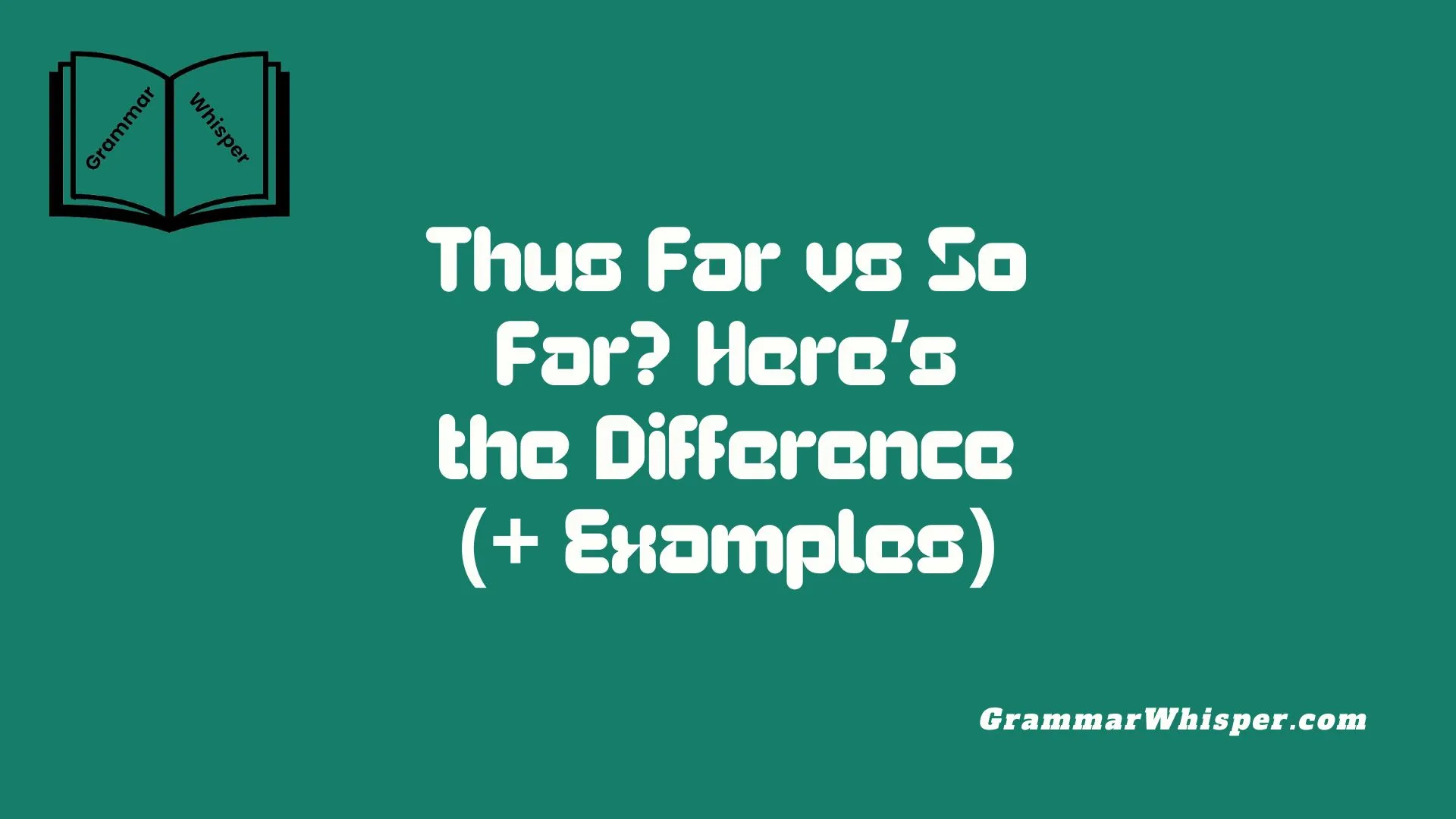When learning English, it’s easy to overlook how tiny expressions or phrases can reveal big differences in style. “Thus Far vs So Far“ both speak to progress and extent, but they differ in tone and formality. During my early days of writing professionally, I would use “thus far” while drafting a formal report – the structure just made sense. In contrast, while in a quick chat with colleagues, “so far” flowed naturally. This kind of usage made me realize how crucial understanding these subtle shifts is. It really sharpened my writing and speaking skills over time.
Being able to communicate with precision in various contexts starts with picking the right phrase. This article serves as a hands-on guide, showing what truly distinguishes the two. Their historical roots also matter – “thus” is often found in more structured academic texts, while “so” comes off as more modern and flexible. Knowing when to use each, and applying them through practical examples, helps you sound more natural and fluent. Whether you’re chatting casually or sticking to a formal script, this small tweak can make your message feel just right – and effortlessly so.
Understanding “Thus Far” and “So Far”
At their core, both thus far and so far mean “up to this point in time.” However, their usage differs in formality and style. Thus far tends to appear in more formal, academic, or official contexts, while so far fits naturally into casual conversation and informal writing.
For example, in a business report, you might read:
“Thus far, the project has met all key milestones.”
In contrast, in everyday talk, you’d likely hear:
“So far, the movie has been really good.”
Both convey progress but carry different tones.
The Historical and Etymological Roots of “Thus” and “So”
The phrase “thus far” derives from the word “thus,” which has Latin origins (from talis meaning “such” or “so”). Historically, thus was widely used in Middle English and earlier texts to indicate manner or degree and has retained a formal and somewhat archaic tone.
On the other hand, “so” has Old English roots, coming from the word swa, meaning “in this way” or “to this extent.” Over centuries, so has evolved into a versatile, informal, and commonly used term in everyday English.
This historical background helps explain why thus far feels formal and traditional, while so far sounds modern and conversational.
Formality and Context: When to Use “Thus Far”
Thus far is best suited for formal settings. It appears frequently in academic papers, legal documents, formal speeches, and official reports.
Situations ideal for “thus far” include:
- Research papers summarizing findings
- Legal statements outlining progress or limitations
- Formal business communications
- Official announcements
Here’s a formal example from a scientific article:
“Thus far, the study confirms the hypothesis under controlled conditions.”
Using thus far in casual settings can sound stiff or outdated, so reserve it for professional or serious contexts.
Versatility and Casualness: When to Use “So Far”
So far is the flexible, informal choice perfect for everyday speech and writing.
You’ll hear it often in:
- Friendly conversations
- Casual emails or texts
- Blogs and social media posts
- Informal presentations
For example:
“So far, I’ve really enjoyed the new restaurant.”
This phrase helps keep communication light, accessible, and natural. Its versatility makes it a safe default for most non-formal situations.
Comparing Meanings and Connotations
Though thus far and so far share similar meanings, their connotations set them apart.
| Feature | Thus Far | So Far |
| Tone | Formal, authoritative | Informal, conversational |
| Typical Contexts | Academic, legal, professional | Casual, everyday |
| Frequency in Speech | Rarely spoken | Very common |
| Perceived Audience | Scholars, officials, professionals | Friends, colleagues, general public |
In essence, thus far communicates a measured, official status update, while so far feels like a friendly progress check.
Grammar and Punctuation Insights
When using thus far or so far, the punctuation often depends on sentence placement.
- If placed at the beginning or middle of a sentence, commas may separate these phrases for clarity: “Thus far, the project is on track.” “The results, so far, are promising.”
- When placed at the end, commas are usually omitted: “We have achieved significant progress so far.”
Common mistakes to avoid:
- Overusing commas unnecessarily, especially in short sentences
- Mixing up “thus far” with similar phrases like “thus far and no further” (which has a specific idiomatic meaning)
The Phrase “Thus Far and No Further”: Meaning and Usage
The idiom “thus far and no further” is a strong statement used to set limits or boundaries, often signaling that progress or tolerance ends here.
Example:
“You may submit your reports thus far and no further until we review the initial findings.”
It conveys finality and authority, often in legal, business, or disciplinary contexts.
Alternatives and Synonyms for Different Contexts
Depending on your writing or speaking needs, you may want to swap thus far or so far for synonyms that suit tone and clarity.
| Phrase | Formality | Usage Example |
| Up to this point | Formal | “Up to this point, the data is inconclusive.” |
| To date | Formal | “To date, the company has expanded globally.” |
| Until now | Informal | “Until now, I hadn’t tried sushi.” |
| As yet | Formal/Informal | “The issue remains unresolved as yet.” |
| So far | Informal | “So far, everything’s going well.” |
Choosing the right synonym helps maintain the intended tone and avoid repetition.
Practical Examples and Case Studies
Academic vs. Casual Usage: A Quick Case Study
In academic writing, formal tone is crucial. Here’s how thus far fits:
“Thus far, our findings indicate a correlation between diet and mental health.”
Conversely, in a casual blog:
“So far, I’ve loved every episode of the new series.”
Comparison Table:
| Context | Phrase Used | Tone | Audience |
| Academic paper | Thus far | Formal | Scholars, experts |
| Business email | Thus far | Professional | Colleagues, clients |
| Casual conversation | So far | Informal | Friends, family |
| Social media post | So far | Conversational | General public |
This shows how phrase choice aligns with audience and purpose.
Summary and Best Practices
To sum up:
- Use thus far in formal, professional, or academic contexts.
- Use so far for informal, everyday conversations.
- Know your audience to choose the right tone.
- Avoid mixing these phrases to maintain clarity.
- Consider synonyms to add variety and precision.
Remember: Choosing between thus far vs so far is about matching tone, setting, and audience expectations. Mastering this subtlety improves your communication dramatically.
Final Thoughts
The phrases thus far and so far may seem interchangeable but convey distinct vibes. Recognizing when to use each phrase will elevate your English communication, whether you’re drafting a report, writing an email, or chatting casually. Use this knowledge to communicate with confidence, clarity, and style.
FAQs
What does “thus far” exactly mean?
“Thus far” means “up to this point” and carries a formal tone used mostly in official or academic contexts.
Can I use “so far” in professional writing?
Generally, so far is more casual. For professional writing, especially formal documents, thus far or synonyms like “to date” are preferred.
Is “thus far” considered old-fashioned?
It’s somewhat traditional and formal but still relevant in academic and legal writing, where a formal tone is required.
Are there other phrases that mean the same as “so far”?
Yes, phrases like “until now,” “as yet,” or “up to this point” can be informal alternatives depending on context.
Can I use “thus far” in spoken English?
You can, but it may sound formal or stiff in casual conversations. Most native speakers prefer “so far” in speech.











